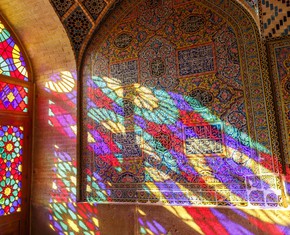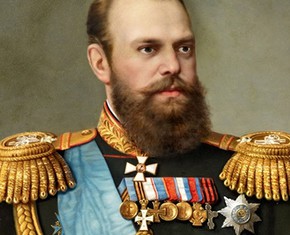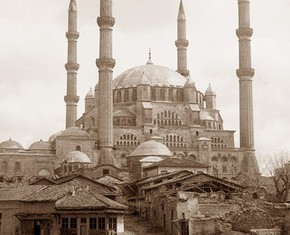The views expressed in our content reflect individual perspectives and do not represent the authoritative views of the Baha'i Faith.
The Harlem Renaissance produced three of America’s most beloved writers—the poets Langston Hughes and Countee Cullen, and the Baha’i philosopher, Alain Locke. These three men, close friends throughout their lives, completely changed America’s–and the world’s–perceptions about what black people could accomplish as artists and intellectuals.
Alain Locke became a Baha’i in 1918—the very same year that he earned his Ph.D. in philosophy from Harvard University. Locke didn’t broadcast his beliefs, and stayed rather private about his Baha’i affiliation, so the question naturally arises as to whether or not his close friends knew. Actually, Langston Hughes and Countee Cullen did know that Locke was a Baha’i. Here’s the proof:
Alain Le Roy Locke
Howard University
Washington, D. C.Dear Countee:
Naturally I am depressed—you as buss-boy [sic] and Langston [Hughes] as galley-slave — when I had in imagination placed the trio in Europe this summer—you with the German mission—Langston with me. . . . I was going to take the same ship—as it is, I will sail the 27th on the Paris or the 30th on the Empress of Britain.
As to Langston [Hughes]—he is a fool—never again—I swear it. For example I had an invitation to the Baha’ist center at Haifa so worded as to include him. I am going to stay there at least a month—and had hoped to do some writing there—Are we really an accursed tribe? What is it — that we never see opportunities . . . .
As for myself — well I am now to be a philosopher, anyway.
With best wishes Sincerely Alain Locke
– Alain Locke to Countee Cullen, n.d. [1923], Countee Cullen Papers, Amistad Research Center, Tulane University.

Langston Hughes
This letter indicates that Shoghi Effendi, the Guardian of the Baha’i Faith, likely granted permission for Langston Hughes to accompany Alain Locke on his Baha’i pilgrimage to Haifa, Palestine. Hughes probably could have accompanied Locke to Haifa had he wished to, as the two previously had rendezvoused in Paris and in Verona. But Hughes declined, which upset Locke: “As to Langston [Hughes]—he is a fool—never again—I swear it.” Who knows if Locke was teasing or truly miffed?
As a Baha’i, Locke undertook two pilgrimages to the Holy Land, in 1923 and 1934. His first pilgrimage was immortalized in a travel narrative—“Impressions of Haifa”—published in 1924, reprinted three times in 1926, 1928, and 1930, and endorsed by Shoghi Effendi. Locke’s trips to Palestine were for the primary purpose of visiting the Baha’i shrines, rather than Jerusalem, the spiritual magnet that attracts most pilgrims bound for the Holy Land. That Haifa was his principal destination attests the primacy of Locke’s religious identity as a Baha’i.
Here are two excerpts from “Impressions of Haifa”—one describing Mount Carmel (where the Shrine of the Bab is located) at the other the city of Akka (where Baha’u’llah was imprisoned, beginning in August 1868):
Everything seems to share the custody of the Message—the place itself is a physical revelation. I shall never forget my first view of it from the terraces of the shrine. Mount Carmel, already casting shadows, was like a dark green curtain behind us and opposite was a gorgeous crescent of hills so glowing with color—gold, sapphire, amethyst as the sunset colors changed—and in between the mottled emerald of the sea, and the grey-toned house-roofs of Haifa…
Almost immediately opposite and picking up the sun’s reflection like polished metal were the ramparts of ‘Akka, transformed for a few moments from its shabby decay into a citadel of light and beauty. Most shrines concentrate the view upon themselves—this one turns itself into a panorama of inspiring loveliness. It is a fine symbol for a Faith that wishes to reconcile the supernatural with the natural, beauty and joy with morality. It is an ideal place for the reconciliation of things that have been artificially and wrongfully put asunder…
Yet the most significant passages in “Impressions of Haifa” are Alain Locke’s descriptions of Shoghi Effendi, and the walk that they enjoyed together while surveying the Baha’i Gardens:
It was a privilege to see and experience these things. But it was still more of a privilege to stand there with the Guardian of the Cause, and to feel that, accessible and inspiring as it was to all who can come and will come, there was available there for him a constant source of inspiration and vision from which to draw, in the accomplishment of his heavy burdens and responsibilities. That thought of communion with ideas and ideals without the mediation of symbols, seemed to me the most reassuring and novel feature. For after all the only enlightened symbol of a religious or moral principle is the figure of a personality endowed to perfection with its qualities and necessary attributes. Earnestly renewing this inheritance seemed the constant concern of this gifted personality, and the quiet but insistent lesson of his temperament…
Refreshingly human after this intense experience, was the relaxation of our walk and talk in the gardens. Here the evidences of love, devotion and service were as concrete and as practical and as human as inside the shrines they had been mystical and abstract and superhuman. Shoghi Effendi is a master of detail as well as of principle, of executive foresight as well as of projective vision. But I have never heard details so redeemed of their natural triviality as when talking to him of the plans for the beautifying and laying out of the terraces and gardens. They were important because they all were meant to dramatize the emotion of the place and quicken the soul even through the senses.
Locke uncharacteristically translated his private appreciation of his experience to a public one. Just as he was a public intellectual in his role as an academic, Locke, in his “Impressions of Haifa,” became a “public” Baha’i pilgrim.
In Alain Locke’s letter, postmarked December 5, 1923 from Cairo, to Shoghi Effendi, Locke, after acknowledging his “safe and pleasant” arrival in Cairo, states that his memory of his week in Haifa “is one of the happiest things I have to cherish—the experience itself being one of the most significant and beneficial experiences of my life.” Locke closes his letter by writing that the best way for him to thank Shoghi Effendi is “to devote my best efforts to the Cause.”
Locke’s poetic prose shows his own talent in writing. Too bad Langston Hughes turned down the invitation!
















Comments
Sign in or create an account
Continue with Googleor